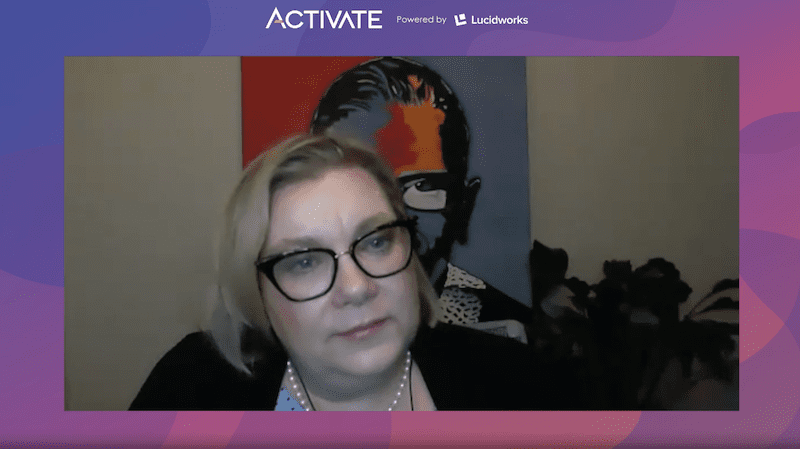Expert Recommendations to Improve the B2B Customer Experience
CDW ecommerce veteran shares how to meet and exceed B2B customer’s expectations.

With 26 years at the company, Anne Vargo is a CDW veteran. Currently Senior Digital Product Manager, she’s spent the bulk of her time at CDW supporting digital commerce initiatives. Over this period, Vargo has had a front row seat to the evolution of B2B ecommerce.
She’s had a good vantage point from CDW, one of the largest B2B companies in the world. It solves IT’s toughest problems with omnichannel strategies for organizations of every size and type, from hundred-year-old companies to startups, healthcare to the U.S. Census. CDW’s breadth of customers exposed Vargo to the diverse needs of different B2B organizations.
Vargo sat down with Lucidworks General Manager of Digital Commerce Peter Curran at Activate Product Discovery to talk about the differences between B2B and B2C customers, and how companies can position themselves to provide the best B2B customer experience. Watch the full interview here:

A B2B Balancing Act
There is an added layer of complexity in the B2B customer relationship that B2C companies don’t have to consider. Not only do B2B customers have their own personal tastes, preferences, and expectations, but they are also balancing these with the expectations, preferences, and needs of the organization they serve.
Of course, employees bring B2C purchasing experiences from their private lives into their B2B role. That means B2B businesses have to stay current with B2C commerce capabilities. Simultaneously, the needs of the employee’s organization have to be considered. For example, quoting and controls around who is allowed to make purchases are all features CDW has built based on customer requirements. By allowing businesses to set these rules, the businesses’ employees are empowered to make decisions suitable to their job roles. Guardrails allow businesses to control spending and give visibility into spending for roles where required.

“Different types of organizations with diverse needs require a system that reacts to a B2B customer’s individual needs in a personalized manner no matter what it is.”
Nurturing the Business-Employee-Business Relationship
“There’s something about a business relationship that is more intimate than the relationship a consumer has with the brand,” Curran reflected. “It doesn’t upset me that Nike doesn’t know exactly what kind of shoe to steer me towards, but man, when my CPA forgets this one thing last year, or the rep for a platform that we’re using didn’t remember something about my business, I really felt kind of cheated. There is something really fragile about that relationship if you don’t nurture it and pay attention to who that buyer is.”
In the case of CDW, the business acts as an extension of its customers’ IT and technology functions. “We really think of ourselves as part of their team,” said Vargo. “Building that relationship, recognizing that relationship, and enabling that relationship, that’s a huge part of doing business with another business. It’s two groups of people working together toward the same goal.”
So providing a top-of-the-line B2B shopping experience is much more than matching a product item number to a product. Customers come to CDW’s website with project sizes as varied as the companies it serves. Some simply need a new cable, for example, but others are looking to support businesses undergoing massive initiatives—like taking a census of the United States—where the sales, vetting, and support processes can be years long. CDW’s website needs to help bring both of these customers to a timely and successful resolution. “What we really need is a system that can help us build that intelligence to be able to react in a personalized manner to a company no matter what it is,” said Vargo.
Forrester analyst Joe Cicman second’s Vargo’s observations, “A successful experience in B2B starts by making it easy to find, compare, and configure products.” With more than 30% of B2B customers buying digitally first and B2B eCommerce reaching $1.8 trillion, accounting for 17% of all B2B sales in the US, by 2023, providing this successful experience can be a sink-or-swim scenario for B2B businesses.

“There’s something about a business relationship that is more intimate than the relationship a consumer has with a brand.”
CDW Empowering Customers with Lucidworks Fusion
A couple years back, CDW found itself with a lot of opportunity left on the table by using an outdated product discovery system on its website. So the team at CDW went on the hunt for a replacement system that could be used to solve not only its customer-facing search needs, but also serve its sellers’ search needs. The new system needed to have out-of-the-box capabilities that would allow CDW to get up and running quickly, but customization that allowed it to be tightly knit into its overall ecosystem.
An exhaustive search landed them with Lucidworks Fusion. ”Since we have rolled out that system, it has opened up a whole new set of capabilities that we didn’t have before. And it changed how we think about things in terms of end to end—from the customer to the seller—and how we’ve implemented the system to be able to listen to both ends of that conversation,” Vargo said.
CDW has seen positive results since the initial implementation of their Fusion-powered search system. A pronounced reduction in the number of no-results searches is one of the most impactful CX improvements. She noted, “We also saw a double digit lift in our add-to-cart conversion metrics, something that we’re really pleased with. We saw a vast improvement in the speed of our search experience, we cut some of our core KPIs almost in half in that respect. And what it all added up to was a really nice little lift in the order conversion rate.”
As CDW progresses with its usage of Fusion, product features beyond search will have compounding benefits. “Taking advantage of that smart system will allow us to find new and creative ways to not only help people find things, but to drive insights for both customers and for our salesforce.”
Omnichannel Double Down
Insights shared across the salesforce and website have a symbiotic relationship. In another Forrester report, “US Foods said that customers who buy online spend 5% more than those who only buy offline.” But, according to Vargo, “It’s not one or the other channel (either online or offline). When somebody does business with you in both channels, you see a cumulative effect. If you’ve done a good job in both of those channels, you become that preferred supplier and you’re going to win more of that business. So having a great digital experience can be pivotal to that because that is often the first time somebody experiences you, the front door that somebody from an organization walks into.”
Watch the full conversation here and read more about CDW’s process—from evaluation to implementation—of their new AI-powered search experience that improved relevancy, reduced null search results, and increased add-to-cart and conversion rate.
Reach out to us today if you’re interested in learning about Lucidworks’ B2B ecommerce solutions.
LEARN MORE
Contact us today to learn how Lucidworks can help your team create powerful search and discovery applications for your customers and employees.